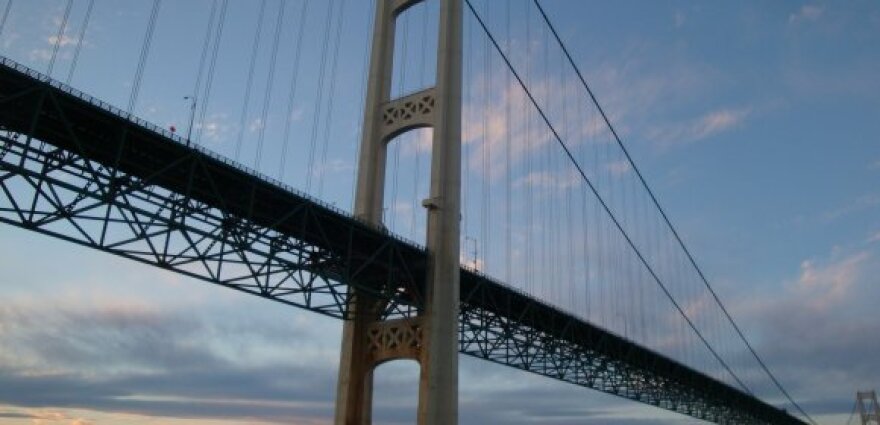A group of U.S. and Canadian citizens that advises the Great Lakes Fishery Commission says an aging pipeline under the Mackinac Bridge should be replaced. They say there’s too much danger of a “catastrophic” oil spill in an “especially sensitive area” with fast-moving currents and frequent ice cover.
Enbridge Energy says this four-mile stretch of “Line 5” meets all modern regulations and that it has seamless metal walls an inch thick. But it is 60 years old, and this is not the first citizen group to call for its replacement.
Committee Of Advisors
The committee is nominated by their governors and Canadian ministers to advise a bi-national fishery commission. Its members are from the charter and commercial fishing industries, as well as citizens at large and government agency representatives.
“After 60 years, you would think it’d have to be replaced. It should be,” says Charter Captain Denny Grinold, the chair of the U.S. Committee of Advisors. He operates a boat out of Grand Haven on Lake Michigan.
Grinold says a spill at the Straits could move rather quickly into other parts of the basin, into central and southern Lake Michigan where he makes his living, or more likely into Lake Huron and down toward Lake St. Clair.
Advice Taken Seriously
The Straits are tumultuous waters connecting two Great Lakes, the kind of place where currents could quickly carry spilled oil great distances. Grinold says the advisors don’t oppose a pipeline running through the Straits, but it has to be safe. And they’re not convinced this one is.
The bi-national Great Lakes Fishery Commission is expected to take this recommendation seriously when it meets again in December.
“We get info from our advisors on a whole number of topics and in many cases what they bring forward to us are some of the top most critical issues that face the Great Lakes,” says Mark Gaden, a commission spokesman. “Remember these are people who are in daily contact with the resource, they have their finger on the pulse of what is going on and the information that they bring to us is critical to the management of the fishery.”
What are the advisors asking of the commission? They want this body, which is appointed by the American president and Canadian authorities, to “call upon all appropriate authorities to require the immediate replacement of Line 5 using the best available technology.”
A growing list of government officials have been more measured, but they’re asking for more information about the pipeline. Most recently Michigan Attorney General Bill Schuette said he wants to know how long the company thinks the pipeline can last before it’s replaced.
Pipeline Passes Muster
The line may have been installed in 1953, but it passes muster of all modern requirements and inspections, according to a spokesman for Enbridge Energy. Jason Manshum also says the pipes are monitored by computer 24 hours a day. He estimates, if a spill were detected under the Mackinac Bridge, it would take two minutes to isolate the flow of oil into the water and 10 minutes or less to get a crew on scene.
But many are leery of the track record of the company responsible for a pipeline that ruptured in 2010, spilling crude into the Kalamazoo River for 17 hours. Cleanup is still underway.
“There is no doubt that the incident in 2010 that impacted the Kalamazoo River here in southern Michigan was one of the worst days in our company’s 60 year history,” says Manshum. The company has since then worked to improve procedures in order to protect the environment, he says, while meeting the region’s refinery needs.
“People who live, work and play – and would rely on the Straits of Mackinac, they have a right to expect that Enbridge will maintain its pipelines to the highest of standards,” he says. “Line 5 is operated and maintained to ensure the continued safe transportation of crude petroleum.”
Public Scrutiny
The public scrutiny of Line 5 under the Straits has come after the Kalamazoo spill, and after a 2012 report of the National Wildlife Federation warning of catastrophic danger with the pipeline at the straits, some parts of which the company disputes. A key question is if so called “tar sands” oils are or ever will be carried through the line. The company says no, but the National Wildlife Federation stands by its report, which is also largely the basis of the resolution passed this month by the Great Lakes Fishery Commission’s citizen advisors.
For one property holder on Mackinac Island, that resolution means more momentum to protect the waters from a dangerous threat. Susan Lenfestey imagines that worst-case scenario of a major spill in her vacationland.
“This would impact it in an almost permanent way, at least a very long time before it ever returned to what it is now,” she says. “So I feel I gotta do all I can to get them out of there (the pipes of Line 5).”
Lenfestey just learned about the twin 20-inch oil and gas pipelines last year.
“They’ve been lying under the water about as long as I’ve been coming to Mackinac,” since Eisenhower was president, she says. “It kind of amazed me that I’d never known they were there.
“I guess we’re lucky that we had never known they’re there.”

